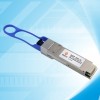Sinovo Telecom100G QSFP28/CFP/CFP2/CFP4 Transceivers
To meet the ever increasing requirement for higher internet speed and greater bandwidth and large demand of data communication and storage from enterprise and data center, the 100G Ethernet network is more and more installed. And for the 100G optical module market, 2016 is a very
100G QSFP28

The 100G QSFP28 is the exact same footprint as the 40G QSFP+. The "Q" is for "Quad" and the QSFP shorts for Quad Small Form-factor Pluggable; just as the 40G QSFP+ is implemented using four 10-Gbps lanes, the 100G QSFP28 is implemented with four 25-Gbps lanes. Just as its name specified, the 100G QSFP28 format specification is evolving to enable higher data rates with and upgraded electrical interface to support signaling up to 28 Gbps signals and reach highest possible rate is 4x28 Gbit/s. That’s the reason 100G QSFP28 comes.
The 100G QSFP28 makes it as easy to deploy 100G networks as 10G networks. When comparing to any of the other alternatives, 100G QSFP28 optical module increases density and decreases power and price per bit. For the reason why the 100G QSFP28 is fast becoming the universal data center form factor, here list two main ones:
The 100G QSFP28 increases front-panel density by 250% over 40G QSFP+. The form factor is the same and the maximum number of ports is the same, but the lane speeds are increased from 10 Gbps to 25 Gbps. The increase in panel density is even more dramatic when compared to some of the other 100-Gbps form factors: 450% versus the CFP2, which we will talk
100G QSFP28 optical modules can be based on either VCSELs that is useful for shorter distances on multimode fiber (MMF) or silicon photonics that is used for longer distances on single mode fiber (SMF). The advent of silicon photonics enables 100G QSFP28 optical module transceivers to support any data center reach up to 2 km transmission distance or more. Silicon photonics is low-power but provides a high degree of integration; even WDM designs can fit within the 3.5 W maximum of QSFP.
100G CFP/CFP2/CFP4

Actually, when the IEEE finished the first 100G standard for Ethernet networks, the transceiver industry launched an alphabet soup of form factors, and the CFP emerged first, the c stands for the Latin letter C used to express the number 100 (centum), since the standard was primarily developed for 100 Gigabit Ethernet systems. And CFP shorts for C form-factor pluggable, which is also a multi-source agreement to produce a common form-factor for the transmission of high-speed digital signals.
The original CFP optical modules are huge at first, but improved a lot in the next version of form factors, the CFP2, CFP4, upon the CFP. Below are the technique specifications of each generation of CFP (fromWiKi):
CFP vs CFP2 vs CFP4

From above specifications, we know that the new generation of 100G CFP4 has improved a lot in width and power consumption, but when compared to the other popular form factors like 40G QSFP+ and 100G QSFP28, none of these new members of the CFP family improved density, power consumption, or cost.
100G QSFP28 and CFP4 Optical Modules
As an excellent supplier of optical modules solution from China, Sinovo provides a complete range of 100G fiber optic transceivers to meet the potential requirements, including: 100G QSFP28 SR4 for 100m






